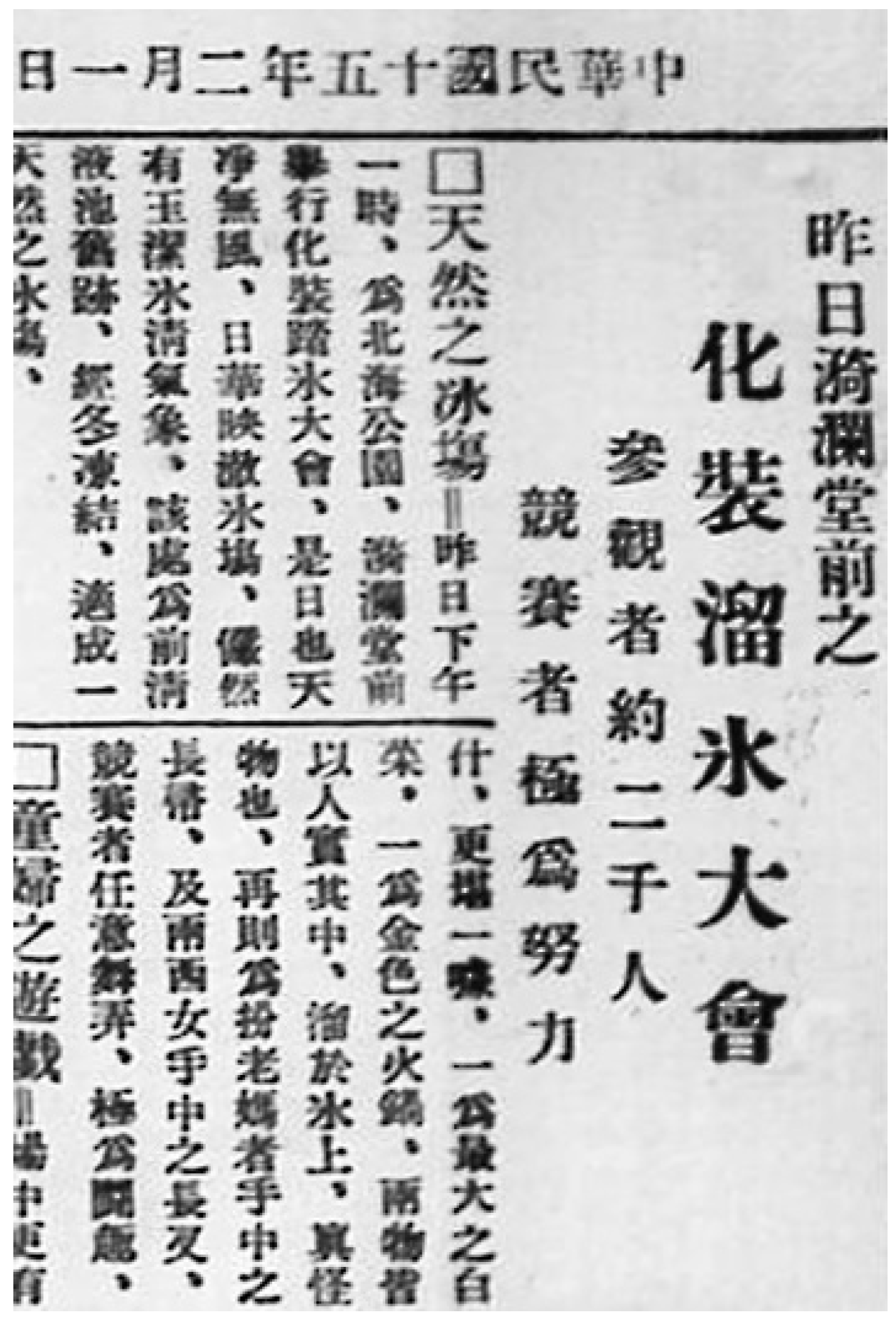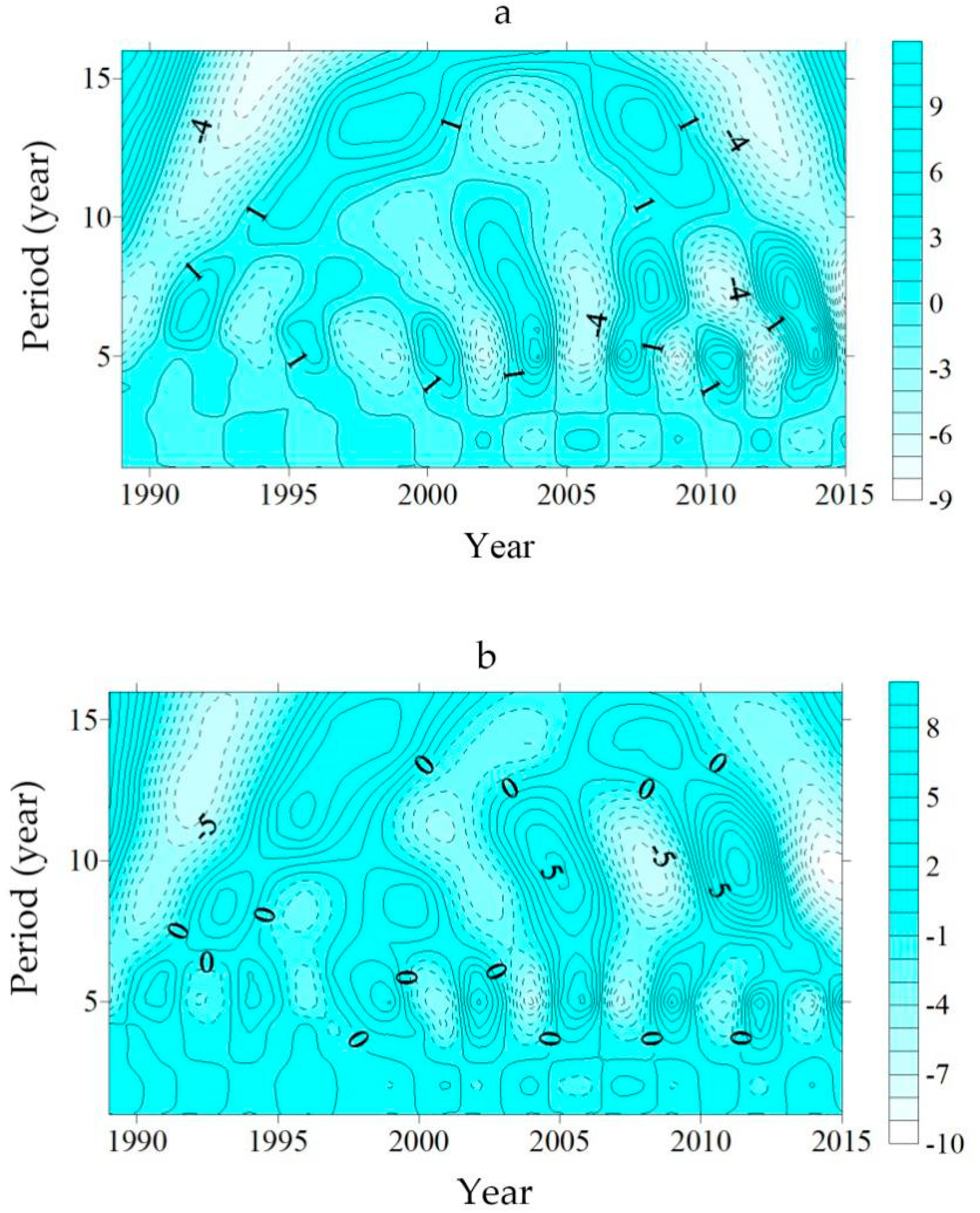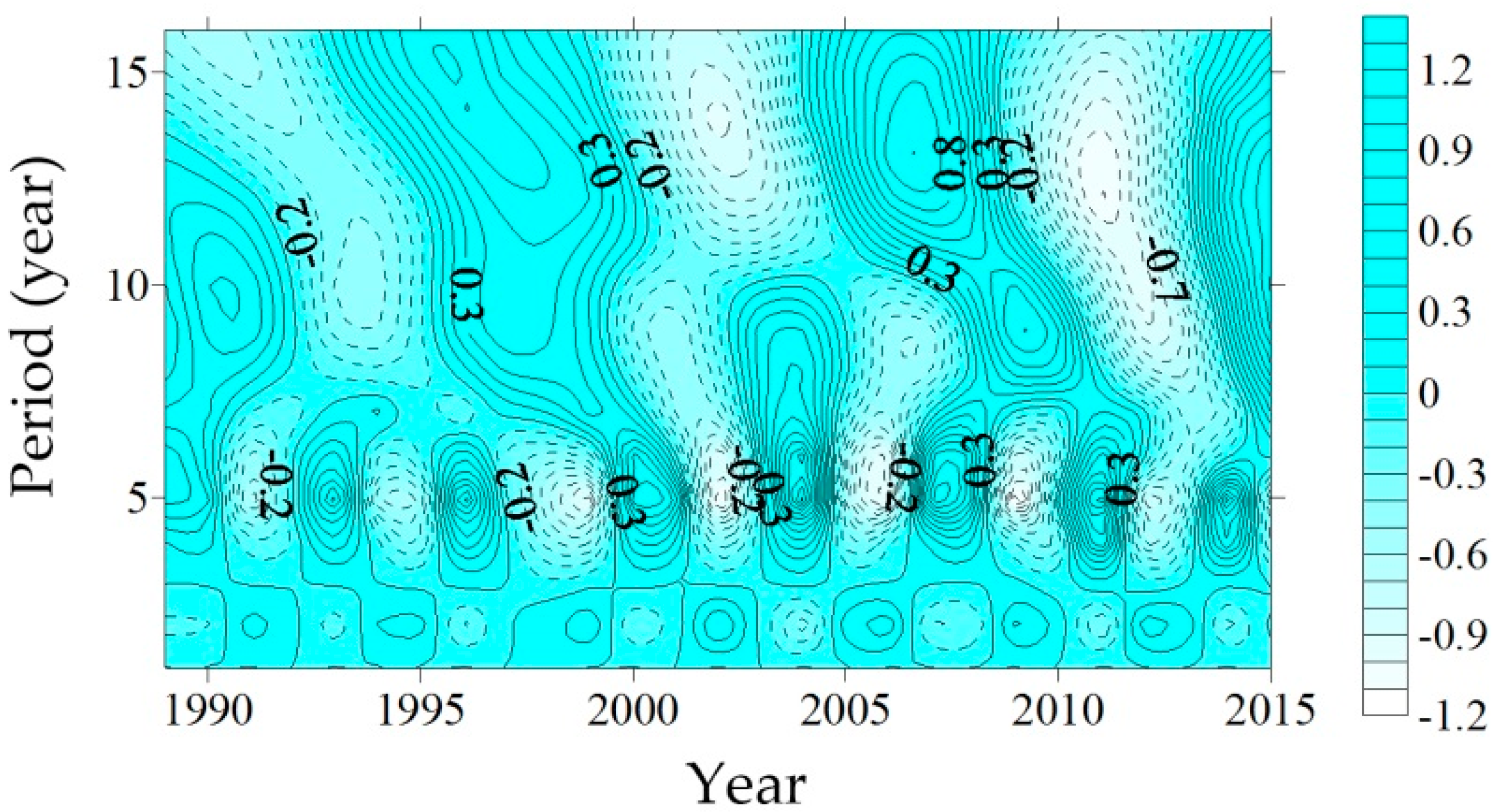Effects of Climate Change on Outdoor Skating in the Bei Hai Park of Beijing and Related Adaptive Strategies
Abstract
:1. Introduction
2. Literature Review
3. Study Area
4. Data Sources and Methodology
4.1. Data Sources
4.2. Methodology
5. Results
5.1. Ice Phenology Change Patterns of the Skating Field
5.2. Main Factors Affecting Ice Phenology
5.3. Effects of Climate Change upon the Skating Field and Adaptive Strategies
It is not cold this year, and it was not very cold last year…now it is becoming warmer on the globe, and this would be a long-term trend. (Skating-related business operator 1)The change is very dramatic. We had the longest open duration of approximately 40 days in the 1980s and 1990s…the operation duration time started to decline in the 1990s…(this year), after the completion of the inspection, there may be more than 10 but less than 20 days (open to the general public). But, the investment—in addition to the current equipment and staff that you can see right now—would also include new investments for staff after the operation of the fields, and (these) would be quite high, and as such, this business may not be profitable in most cases—or simply does not have a deficit. (Skating field operator 7)
Our first concern is safety. If there are too many visitors, we would take some measures to limit the number of visitors (using) the skating field during a given time interval. We will make judgments based on two criteria: the first is the 15 cm thickness standard for ice layers, and the second is the density of 10 square meters per person…Provided the temperature is higher, the range certainly would be a little greater. (Skating field operator 1)
Bei Hai Park is still considered the most authentic source place for recreation on ice. Therefore, after the opening of the field in this year, we (will) collaborate with the Sport Bureau and will hold three recreational ice events, with a recovery of the Eight Manners—which was explored once last year and proven very successful. These items are very precious, but may be difficult to recover, and now they are under a slow process. (Skating field operator 7)I have no measures. The field is closed in warm weather. It absolutely should not be opened in order to ensure the safety of visitors. Moreover, the ice definitely would not pass the inspection. This business totally depends on the weather. (Skating field operator 6)
Nowadays, there is a type of simulated ice floor where you can skate with normal ice skates, and it will give you the same feeling as (when) you skate on real ice. There is no need for equipment that is used in indoor ice fields to make ice. The simulated ice fields have very low cost, and would not be affected even (on) a sunny day. (Relevant operator 3)The generation of my father was committed to this business (and) very hard working, (thus) making the handicraft gradually recognized and accepted by the general public until now in my generation. Even if only one person skated, I would persist doing this business. My father had devoted his whole lifetime to this business, (as) would I. This is inheritance. (Skating-related business operator 4)
5.4. Effects of Climate Change upon Frequent Skaters and Their Adaptive Strategies
(Skating time) on the whole is decreased, and now it is only a little longer than one month, showing much decrease as compared with previous time. It was about in the 1980s that the skating time could be as long as three months. I remember that the ice formed on November (20th), and the field was officially opened around early December…In the 1990s, the field (official opening day) was also around mid-December, and it was mainly after the 2000s that the weather became warmer, and it was approximately around 1995 or 2000 when the skating time began to shorten. (Frequent visitor 7)
The impact was huge. (This year) the opening dates were at least half (a) month later than previous years, and moreover, the surface was not good enough. I have a strict requirement for ice surface quality, and would not come if the quality is too bad. (Frequent visitor 32)
Many people leave Beijing in late October to early November to go to the northeast for skating. (Frequent visitor 33)Some people go to Qiqihaer. They leave as soon as the ice here softens. (Frequent visitor 32)Some people even go to the northeast for skating, but my schedule does not permit…(later) it will depend on the schedule. If the schedule permits, I would consider (skating in the northeast). (Frequent visitor 34)
Indoor skating fields are better. There is a wind outside, and therefore there will be sands on the ice surface, which would make the blades be worn out more quickly. (Indoor fields) are not as big as this field, but they are very standard—which is quite important to those playing ice hockey games. (Frequent visitor 9)Then I will not skate, and do the roller skating instead. (Frequent visitor 2)In summer we go roller skating, and (there) are speed roller skater shoes. We conduct roller skating in the Bird Nest in summer. (Frequent visitor 4)
We usually go wild skating…You just need to take a look at the ice. Isn’t it transparent? A thickness of 6–7 cm is good enough…The business operation requires a thickness of 15 cm, but there is no thickness requirement in wild skating, as long as you can keep yourself safe and do not fall in the water. (Frequent visitor 30)
6. Discussion and Conclusions
6.1. Discussion
6.2. Conclusions
Acknowledgments
Author Contributions
Conflicts of Interest
References
- Morrison, C.; Pickering, C.M. Perceptions of climate change impacts, adaptation and limits to adaption in the Australian Alps: The ski-tourism industry and key stakeholders. J. Sustain. Tour. 2013, 21, 173–191. [Google Scholar] [CrossRef]
- Scott, D. Why sustainable tourism must address climate change. J. Sustain. Tour. 2011, 19, 17–34. [Google Scholar] [CrossRef]
- Wang, L.; Ge, Q.; Ning, Z.; Cui, H.; Dai, J.; Zhong, S.; Wang, H. Effect of phenological change in ornamental plants on the dates of spring outings to popular locations, Beijing, China. Clim. Res. 2017, 72, 177–182. [Google Scholar] [CrossRef]
- Gilaberte Búrdalo, M.; López Martín, F.; Pino Otín, M.R.; López Moreno, J.I. Impacts of climate change on ski industry. Environ. Sci. Policy 2014, 44, 51–61. [Google Scholar] [CrossRef]
- Cao, L.; Zhu, Y.; Tang, G.; Yuan, F.; Yan, Z. Climatic warming in china according to a homogenized data set from 2419 stations. Int. J. Climatol. 2016, 36, 4384–4392. [Google Scholar] [CrossRef]
- IPCC. Climate Change 2014 Synthesis Report; IPCC: Geneva, Switzerland, 2014; p. 151. [Google Scholar]
- Li, S.; Yang, S. Changes of extreme temperature events in Beijing during 1960–2014. Sci. Geogr. Sin. 2015, 35, 1640–1647. [Google Scholar] [CrossRef]
- Qi, Z. Traditional physical cultural implication of manzu nationality by appreciating “picture of ice-skating game”. J. Shenyang Sport Univ. 2009, 28, 118–121. [Google Scholar]
- Witmer, U. Erfassung, Bearbeitung und Kartierung von Schneedaten in der Schweiz; University of Bern—Geographical Institiute: Bern, Germany, 1986; Volume 6, pp. 1–215. [Google Scholar]
- Elsasser, H.; Messerli, P. The vulnerability of the snow industry in the Swiss Alps. Mt. Res. Dev. 2001, 21, 335–339. [Google Scholar] [CrossRef]
- Elsasser, H.; Burki, R. Climate change as a threat to tourism in the Alps. Clim. Res. 2002, 20, 253–257. [Google Scholar] [CrossRef]
- Whetton, P.; Haylock, M.; Galloway, R. Climate change and snow-cover duration in the Australian Alps. Clim. Chang. 1996, 32, 447–479. [Google Scholar] [CrossRef]
- Moen, J.; Fredman, P. Effects of climate change on alpine skiing in sweden. J. Sustain. Tour. 2007, 15, 418–437. [Google Scholar] [CrossRef]
- Damyanov, N.N.; Damon Matthews, H.; Mysak, L.A. Observed decreases in the canadian outdoor skating season due to recent winter warming. Environ. Res. Lett. 2012, 7, 014028. [Google Scholar] [CrossRef]
- Brammer, J.R.; Samson, J.; Humphries, M.M. Declining availability of outdoor skating in canada. Nat. Clim. Chang. 2014, 5, 2–4. [Google Scholar] [CrossRef]
- Robertson, C.; McLeman, R.; Lawrence, H. Winters too warm to skate? Citizen-science reported variability in availability of outdoor skating in canada. Can. Geogr. Le Géogr. Can. 2015, 59, 383–390. [Google Scholar] [CrossRef]
- Fiennes, A.; Melcher, G.; Ruedi, T.P. Winter sports injuries in a snowless year skiing, ice skating, and tobogganing. Br. Med. J. 1990, 300, 659–661. [Google Scholar] [CrossRef]
- Smith, J.W.; Seekamp, E.; McCreary, A.; Davenport, M.; Kanazawa, M.; Holmberg, K.; Wilson, B.; Nieber, J. Shifting demand for winter outdoor recreation along the north shore of Lake Superior under variable rates of climate change: A finite-mixture modeling approach. Ecol. Econ. 2016, 123, 1–13. [Google Scholar] [CrossRef]
- Amelung, B.; Nicholls, S.; Viner, D. Implications of global climate change for tourism flows and seasonality. J. Travel Res. 2007, 45, 285–296. [Google Scholar] [CrossRef]
- Rutty, M.; Scott, D.; Johnson, P.; Pons, M.; Steiger, R.; Vilella, M. Using ski industry response to climatic variability to assess climate change risk: An analogue study in eastern canada. Tour. Manag. 2017, 58, 196–204. [Google Scholar] [CrossRef]
- François, H.; Morin, S.; Lafaysse, M.; George-Marcelpoil, E. Crossing numerical simulations of snow conditions with a spatially-resolved socio-economic database of ski resorts: A proof of concept in the French Alps. Cold Reg. Sci. Technol. 2014, 108, 98–112. [Google Scholar] [CrossRef]
- Klein, G.; Vitasse, Y.; Rixen, C.; Marty, C.; Rebetez, M. Shorter snow cover duration since 1970 in the swiss alps due to earlier snowmelt more than to later snow onset. Clim. Chang. 2016, 139, 637–649. [Google Scholar] [CrossRef]
- Bonzanigo, L.; Giupponi, C.; Balbi, S. Sustainable tourism planning and climate change adaptation in the Alps: A case study of winter tourism in mountain communities in the dolomites. J. Sustain. Tour. 2016, 24, 637–652. [Google Scholar] [CrossRef]
- Butsic, V.; Hanak, E.; Valletta, R.G. Climate change and housing prices: Hedonic estimates for ski resorts in western North America. Land Econ. 2011, 87, 75–91. [Google Scholar] [CrossRef]
- Pickering, C. Changes in demand for tourism with climate change: A case study of visitation patterns to six ski resorts in Australia. J. Sustain. Tour. 2011, 19, 767–781. [Google Scholar] [CrossRef]
- Hopkins, D.; Maclean, K. Climate change perceptions and responses in Scotland’s ski industry. Tour. Geogr. 2014, 16, 400–414. [Google Scholar] [CrossRef]
- Hopkins, D. The perceived risks of local climate change in Queenstown, New Zealand. Curr. Issues Tour. 2015, 18, 947–965. [Google Scholar] [CrossRef]
- Scott, D.; McBoyle, G. Climate change adaptation in the ski industry. Mitig. Adapt. Strateg. Glob. Chang. 2007, 12, 1411–1431. [Google Scholar] [CrossRef]
- Wang, S.; He, Y.; Song, X. Impacts of climate warming on alpine glacier tourism and adaptive measures: A case study of baishui glacier no. 1 in Yulong Snow Mountain, southwestern china. J. Earth Sci. 2010, 21, 166–178. [Google Scholar] [CrossRef]
- Yan, Y.; Zhang, Y.; Shan, P.; Zhao, C.; Wang, C.; Deng, H. Snow cover dynamics in and around the Shangri-La county, southeast margin of the tibetan plateau, 1974–2012: The influence of climate change and local tourism activities. Int. J. Sustain. Dev. World Ecol. 2014, 22, 156–164. [Google Scholar] [CrossRef]
- Intergovernmental Panel on Climate Change (IPCC). IPCC Climate Change Impacts, Adaptation, and Vulnerability, Summaries, Frequently Asked Questions, and Cross-Chapter Boxes; IPCC: Geneva, Switzerland, 2014. [Google Scholar]
- Hopkins, D. Public opinion: Country comparisons. Nat. Clim. Chang. 2015, 5, 975–976. [Google Scholar] [CrossRef]
- Trawoger, L. Convinced, ambivalent or annoyed: Tyrolean ski tourism stakeholders and their perceptions of climate change. Tour. Manag. 2014, 40, 338–351. [Google Scholar] [CrossRef] [PubMed]
- Haanpää, S.; Juhola, S.; Landauer, M. Adapting to climate change: Perceptions of vulnerability of down-hill ski area operators in southern and middle Finland. Curr. Issues Tour. 2015, 18, 966–978. [Google Scholar] [CrossRef]
- Hopkins, D. The sustainability of climate change adaptation strategies in New Zealand’s ski industry: A range of stakeholder perceptions. J. Sustain. Tour. 2014, 22, 107–126. [Google Scholar] [CrossRef]
- Matasci, C.; Kruse, S.; Barawid, N.; Thalmann, P. Exploring barriers to climate change adaptation in the swiss tourism sector. Mitig. Adapt. Strateg. Glob. Chang. 2014, 19, 1239–1254. [Google Scholar] [CrossRef]
- Lee, T.M.; Markowitz, E.M.; Howe, P.D.; Ko, C.-Y.; Leiserowitz, A.A. Predictors of public climate change awareness and risk perception around the world. Nat. Clim. Chang. 2015, 5, 1014–1020. [Google Scholar] [CrossRef]
- Hornsey, M.J.; Harris, E.A.; Bain, P.G.; Fielding, K.S. Meta-analyses of the determinants and outcomes of belief in climate change. Nat. Clim. Chang. 2016, 6, 622–626. [Google Scholar] [CrossRef]
- Zhang, Y.; Meng, W.; Chen, D.; Guo, W.; Wang, J. The trend of variation for low temperature days over Beijing and its surrounding area. Chin. J. Agrometeorol. 2011, 32, 33–37. [Google Scholar]
- Alutu, T. Song Dynasty History; Zhonghua Book Company: Beijing, China, 1985. [Google Scholar]
- The Palace Museum. Painting of Ice-Skating Game. Available online: http://www.dpm.org.cn/collection/paint/233288.html (accessed on 18 August 2016).
- China Meteorological Date Sharing Network. Monthly Value Dataset of Chinese Ground Annual Value; China Meteorological Date Sharing Center: Beijing, China, 1989. [Google Scholar]
- He, W.; Bu, R.; Xiong, Z.; Hu, Y. Characteristics of temperature and precipitation in Northeastern China from 1961 to 2005. Acta Ecol. Sin. 2013, 33, 519–531. [Google Scholar] [CrossRef]
- Liu, J.; Li, Y.; Liu, H.; Ge, Q.; Dai, J. Climate change and peach blossom viewing: Impact and adaptation. Geogr. Res. 2016, 35, 504–512. [Google Scholar]
- Pindoriya, N.M.; Singh, S.N.; Singh, S.K. An Adaptive Wavelet Neural Network-Based Energy Price Forecasting in Electricity Markets. IEEE Trans. Power Syst. 2008, 23, 1423–1432. [Google Scholar] [CrossRef]
- Zhang, Z.; Wang, Y.; Yang, Y.; Ye, J.; Zhou, Y.; Hao, Y.; Jiang, A. Changes and prediction of florescence of ligneous plants in Nanjing. Ecol. Sci. 2014, 33, 642–648. [Google Scholar]
- Zhang, A.; Zhang, J.; Ga, Y.; Guo, W.; Wang, H. Prediction of first flowering date of prunus discoidea in Beijing Yuyuantan Park using phenological medel. Meteorol. Sci. Technol. 2015, 43, 309–313. [Google Scholar]
- Magee, M.R.; Wu, C.H. Effects of changing climate on ice cover in three morphometrically different lakes. Hydrol. Proc. 2017, 31, 308–323. [Google Scholar] [CrossRef]
- Yang, J.; Yang, X.; Zhang, C.; Zhou, H.; Zhang, C. Variation characterisrtics of ice days in Shiyang River basin. Arid Land Geogr. 2016, 39, 712–720. [Google Scholar]
- Xu, S.; Lin, Z.; Li, J. Developing the curling to promote 300 million people participating in winter sports. China Winter Sports 2016, 38, 35–40. [Google Scholar]
- Myers, T.A.; Maibach, E.W.; Roser-Renouf, C.; Akerlof, K.; Leiserowitz, A.A. The relationship between personal experience and belief in the reality of global warming. Nat. Clim. Chang. 2012, 3, 343–347. [Google Scholar] [CrossRef]






| Variable | Test Type a | ADF Statistic | 1% Level | 5% Level | 10% Level |
|---|---|---|---|---|---|
| Opening date | (C,T,1) | −5.039 | −4.374 | −3.603 | −3.238 |
| Duration | (C,T,1) | −4.361 | −4.374 | −3.603 | −3.238 |
| Tem10 b | (C,T,1) | −4.116 | −4.374 | −3.603 | −3.238 |
| Tem11 | (C,T,1) | −4.578 | −4.374 | −3.603 | −3.238 |
| Tem12 | (C,T,1) | −5.079 | −4.394 | −3.612 | −3.243 |
| Tem1 | (C,T,1) | −4.055 | −4.374 | −3.603 | −3.238 |
| Tem2 | (C,T,1) | −5.171 | −4.374 | −3.603 | −3.238 |
| Tem3 | (C,T,1) | −5.563 | −4.374 | −3.603 | −3.238 |
| Tem4 | (C,T,1) | −5.941 | −4.374 | −3.603 | −3.238 |
| Variable | Test Type a | ADF Statistic | 1% Level | 5% Level | 10% Level |
|---|---|---|---|---|---|
| Opening date | (0,0,0) | −3.629 | −2.661 | −1.955 | −1.609 |
| Duration | (0,0,0) | −3.152 | −2.661 | −1.955 | −1.609 |
| Open Area (m2) | 1991 | 1992 | 1993 | 2009 | 2010 | 2011 |
|---|---|---|---|---|---|---|
| Mean | 14,300 | 13,000 | 15,000 | 2000 | 6000 | 6000 |
| Three-year mean | 14,100 | 4667 | ||||
© 2017 by the authors. Licensee MDPI, Basel, Switzerland. This article is an open access article distributed under the terms and conditions of the Creative Commons Attribution (CC BY) license (http://creativecommons.org/licenses/by/4.0/).
Share and Cite
Liu, J.; Cheng, H.; Sun, X.; Huang, L.; Fan, Q.; Liu, H. Effects of Climate Change on Outdoor Skating in the Bei Hai Park of Beijing and Related Adaptive Strategies. Sustainability 2017, 9, 1147. https://doi.org/10.3390/su9071147
Liu J, Cheng H, Sun X, Huang L, Fan Q, Liu H. Effects of Climate Change on Outdoor Skating in the Bei Hai Park of Beijing and Related Adaptive Strategies. Sustainability. 2017; 9(7):1147. https://doi.org/10.3390/su9071147
Chicago/Turabian StyleLiu, Jun, Han Cheng, Xiaoqian Sun, Li Huang, Qiuchan Fan, and Haolong Liu. 2017. "Effects of Climate Change on Outdoor Skating in the Bei Hai Park of Beijing and Related Adaptive Strategies" Sustainability 9, no. 7: 1147. https://doi.org/10.3390/su9071147





